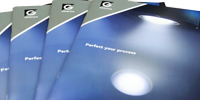Magnetron sputtering fundamentals
The concept of sputtering was first described by Grove (1852) and Plücker (1858), who reported vaporization and film formation of metal films by "spluttering" or "cathode disintegration".
Thomas Edison in 1902 provided the first commercial application of sputtering of gold onto hard wax recording media.
However, it wasn’t until the 1970s before magnetron sputtering had wider use due to the growth of semiconductor solid state technology and in the 1980s with the introduction of optical recording media.
The basic process of sputtering involves a magnetron and its target material being arranged within a vacuum chamber along with a substrate, onto which a thin film is to be deposited.
Magnetron sputtering is generally a physical vapour deposition method where material from a target is being removed, and transferred onto a substrate by effects of high energy collisions on the target.
Ionization occurs within a plasma due to collisions with electrons, and the ions are attracted towards a negatively biased target, producing the high energy collision, which removes target material into the vapour phase.
In magnetron sputtering, the electrons in the plasma are confined due to the magnetic field and electric field trap.
Sputtering is a process that is widely used in a wide range of applications, from coating of food packaging to keep moisture and oxygen out of the packaging and preserve the contained food, to scratch-resistant coatings that are commonly used for glass and touchscreens.
Magnetron sputter deposition has significant advantages over other deposition techniques, such as the range of target materials that can be used, and the durability of the coatings.
As technology continues to improve, so too does the quality of the coatings that can be achieved, with increased target utilization and greater reliability resulting in longer process and lower costs.


